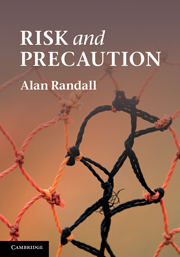Book contents
- Frontmatter
- Contents
- List of figures
- List of boxes
- Authors cited
- Acknowledgements
- List of acronyms
- Part I The precautionary principle – why so much fuss about such a simple idea?
- Part II Harm and chance – managing risk
- Part III Defining and justifying a coherent precautionary principle
- 6 A defensible precautionary principle must withstand these challenges
- 7 Toward a precautionary principle framework: evidence, threat, and remedy
- 8 Threat and evidence
- 9 Remedy
- 10 Precaution for utilitarians?
- 11 A robust and defensible precautionary principle
- Part IV Precaution in action
- Part V Conclusion
- References
- Index
7 - Toward a precautionary principle framework: evidence, threat, and remedy
Published online by Cambridge University Press: 05 June 2012
- Frontmatter
- Contents
- List of figures
- List of boxes
- Authors cited
- Acknowledgements
- List of acronyms
- Part I The precautionary principle – why so much fuss about such a simple idea?
- Part II Harm and chance – managing risk
- Part III Defining and justifying a coherent precautionary principle
- 6 A defensible precautionary principle must withstand these challenges
- 7 Toward a precautionary principle framework: evidence, threat, and remedy
- 8 Threat and evidence
- 9 Remedy
- 10 Precaution for utilitarians?
- 11 A robust and defensible precautionary principle
- Part IV Precaution in action
- Part V Conclusion
- References
- Index
Summary
The objective of this chapter is to outline an approach to a potentially meaningful and coherent precautionary principle. Such a PP must make a distinct contribution beyond ordinary risk management to the policy and management toolkit for dealing with threatened harmful prospects, and it must survive the criticisms discussed in Chapter 6. Several commentators (Gardiner 2006, Mandel and Gathii 2006) have identified one part of the task – to strengthen the weak versions of the PP without succumbing to the criticisms that have wounded overly strong PPs. I would set the goal higher than Mandel and Gathii did, to specify a coherent PP that has more structure and force than a soft norm, but stop short of an imperative to avoid all risks.
Most formulations of PP mention something about potential for harm, something about uncertainty of harm, and something about the action appropriate to these circumstances (Bergen Declaration 1990, Wingspread Statement 1998, UNESCO 2005). The differences among them revolve around exactly what is said about harm, uncertainty, and action. Commentators have argued that the problems with these formulations are due to, or at least exacerbated by, rather weak connections between these three elements – harm, uncertainty, and action (Manson 2002, Hughes 2006). The framework offered in this and the next several chapters is intended to define a PP that explicitly relates harm, uncertainty, and action; and does it in ways that:
structure the PP framework;
take damage conditions, knowledge conditions, and remedies, and the relationships among them seriously; and
do this in ways that define a coherent PP and its domain of application.
- Type
- Chapter
- Information
- Risk and Precaution , pp. 102 - 108Publisher: Cambridge University PressPrint publication year: 2011



